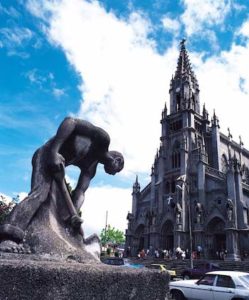
*On this date, in 1824, Costa Rica abolished slavery.
The first Blacks that arrived in Costa Rica came with the Spanish conquistadors. The slave trade was common in all the countries conquered by Spain, and in Costa Rica, the first Blacks seem to have come from specific sources in Africa's Equatorial and Western regions. The people from these areas were considered ideal slaves because they had a reputation for being more robust, generous, and hard-working than other Africans. During the seventeenth century, the elite from the then capital city of Cartago invested in cacao farms in Matina, in the Atlantic region.
The story of the African population in Costa Rica started, as does the story in most South and Central American countries, with slavery. From the beginning, this group was indispensable in agricultural chores and cacao and banana plantations. Their participation was also central in constructing the railroad connecting the country's interior with the coast and the rest of the world. However, Blacks didn't only contribute to the economy and progress of the nation, since elements of their culture, such as their language, religion, food, and music, shaped a whole new culture in the Caribbean and eventually extended to the rest of the country.
Black slaves worked and lived on these farms, isolated from the rest of the country; the owners only went to oversee the crops once a year. However, the following century witnessed a gradual lessening of the abysmal differences between Blacks and their white owners. As whites took Black women as their concubines, they freed the children born from the unions. The same thing started with the "zambos," or the children of the unions between Indians and Blacks. Some analysts have suggested that this tendency to free slaves was due in part to the desire of the owners to free themselves of the economic burden that slaves had become in a poor country such as Costa Rica. The gradual freeing of slaves was happening around the time of the Independence of Costa Rica from Spain (1821); slavery was a disintegrating institution.
The Federal Assembly of Guatemala declared the abolition of slavery in the region in 1822, but this law wasn't fully implemented in Costa Rica until April 17, 1824. By the time the law was established, the slave population in the country was considerably lower since many slaves had been freed previously. In 1871, the railroad to the Atlantic started being built. Henry Meiggs Keith, an American hired by the Costa Rican government, was in charge of this job. He insisted on utilizing Blacks to clear the forest and build the railroad tracks.
Several workers arrived from the Caribbean, Panama, and other countries, but in 1872, the first Jamaicans entered the country. Black Jamaicans and their descendants would become the principal inhabitants of the region and the basis for a culture that was entirely different from any other in the country. The two large Jamaican migrations occurred during the railroad construction and in the next century for the banana plantations owned by the United Standard Fruit Company. If it hadn't been for this influx of the black population, Costa Rica wouldn't have become the world's largest producer of bananas in 1911.
By the 1920s, the Black population had improved economically through farms or jobs with the banana company. However, since they weren't even considered citizens of Costa Rica, they didn't possess legal rights to own land. In the 1930s, many white Ticos moved into this region and took over the land of the Blacks. Many Blacks migrated to Panama or other countries when they were dispossessed of their land or jobs at the banana company. Due to these repressive circumstances, many Black workers organized strikes and labor unions. They even participated with Figueres (revolutionary leader) in the 1948 Civil War, after which they won citizenship and full guarantees. After that, their rights were protected per their union law, and the Africans started prospering in Costa Rica.
Currently, 3% of the population is of Black African descent (Afro Costa Ricans) and are English-speaking descendants of 19th-century Black Jamaican immigrant workers. The indigenous population is around 1%, 41,338 individuals. In the Guanacaste Province, a significant portion of the population descends from a mix of local Amerindians, Africans, and Spaniards. Most Afro-Costa Ricans are found in the Limón Province.